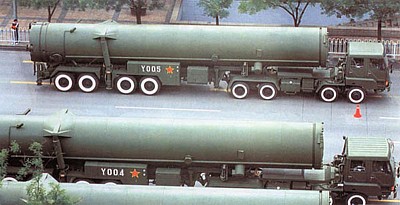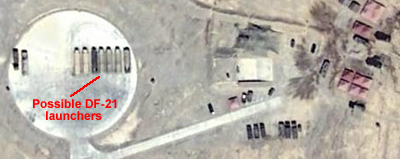Chinese Nuclear Arsenal Increased by 25 Percent Since 2006, Pentagon Report Indicates
 |
| China’s nuclear weapons arsenal has increased by 25 percent since 2006, Pentagon reports indicate, due to deployment of new ballistic and cruise missiles. |
By Hans M. Kristensen
| Updated April 8, 2008 |
The Pentagon’s 2008 annual report to Congress on China’s military power indicates, when compared with previous versions, that China has increased its nuclear arsenal by 25 percent since 2006. The increase has happened due to deployment of new long-range solid fueled ballistic missiles and cruise missiles.
Part of the increase can be expected to be offset by retirement of older liquid fueled missiles over the next several years, but the trend is toward a slightly larger arsenal in the future.
As a reminder of the tendency to estimate too much too soon, however, the 2008 report lowers the range estimates for all three types of China’s new long-range ballistic missiles, one of them by as much as 10 percent.
DF-31 and DF-31A Being Deployed
A decade after the Department of Defense (DOD) first projected the DF-31 would be deployed, the 2008 report finally concludes that the missile is “now being deployed to units within the Second Artillery Corps.” The report lists less than 10 (“<10”) DF-31 missiles deployed on as many launchers. Last year’s report listed the DF-31 as having achieved “initial threat availability in 2006” and possible “operational status” by May 2007.
| Figure 1: DF-31 Deployment Said to be Underway |
 |
| The DOD reports says the DF-31 (shown here) and its longer-range DF-31A version are now being deployed to Second Artillery Corps units. |
–
More surprising is that the DF-31A is now said to be deploying. The missile, which is a longer-range version of the DF-31, has not previously been reported flight tested or with “initial threat availability,” but less than 10 missiles are now said to be deploying to Second Artillery Corps units. Like the DF-5, which has been operational since 1981, the DF-31A can target the Continental United States, and much of the intelligence community’s 2001 prediction of “about 75 to 100 warheads deployed primarily against the United States” by 2015 hinges upon whether China deploys 40-55 DF-31As over the next eight years (see pp. 39-41 in Chinese Nuclear Forces and U.S. Nuclear War Planning, FAS/NRDC, November 2006).
The range estimates for both missiles are lowered. The range for the DF-31 is lowered by 50 km from 7,250+ to 7,200 km (4,505+ to 4,474 miles), after it was thought only a few year ago that the range was 8,000+ km (4,971+). The DF-31 cannot be used to target the Continental United States, and will only be able to reach Hawaii from the most North-Eastern districts of China.
The DF-31A range estimate is lowered from 11,270+ to 11,200 (7,003+ to 6,959+ miles), or to a range 14 percent less than that of the DF-5A.
The Mysterious Growth of the DF-21 Force
A significant portion of the arsenal increase comes from additional DF-21 (CSS-5) that the Pentagon says have been deployed since 2006. The 2008 report estimates that 60-80 DF-21s are now deployed with 60 launchers, significantly more than the 40-50 missiles estimated to be deployed with 34-38 launchers in 2007, and the 19-50 missiles stated in the 2006 report.
Previous versions of the DOD report listed two versions of the DF-21 – Mod 1 and Mod 2 – but the 2008 report only lists one nuclear version with no Mod-number.
It is possible, although not clear from the DOD report, that the 60-80 DF-21s include the “conventionally-armed ASBMs [Anti-Ship Ballistic Missiles] based on the SS-5 (DF-21) airframe,” that the report also describe. Since the “Nuclear Force Structure” section of the report only describes “upwards of 50 CSS-5 road mobile, solid fueled SRBMs (for regional deterrence missions),” it is possible that the remaining 20, or so, DF-21s refer to the conventional ASBMs. Consequently, I have only counted 60 nuclear DF-21s in this estimate.
In July 2007, I described changes to the missile launch sites at Delingha, which indicated deployment of DF-21 missiles at the sites (see Figure 2). The DF-21 has been replacing DF-3As since the early 1990s at a slow rate.
| Figure 2: Possible DF-21 Deployment at Delingha |
 |
| An increase in deployed DF-21 medium-range ballistic missiles is reported by the Pentagon. Commercial satellite images in 2007 indicated possible DF-21 deployment at Delingha in the northern parts of Central China. |
–
DF-25, What DF-25?
The DOD report is quiet on the new missile launcher that appeared on images (see Figure 3) circulating on the Internet in 2007. The images led many to speculate that the earlier DF-25, widely believed to have been canceled, had been revived and deployed with as many as three nuclear warheads.
I doubted that assessment – China is not known to have deployed multiple warheads on any of its ballistic missiles – and asked Air Force Intelligence officials on several occasions last year to comment on the images. They told me that they had seen the photo but were not ready to officially comment yet. Nor is apparently the Office of the Secretary of Defense, and the silence of the 2008 report on this development indicates that the “DF-25” instead may be the “conventionally-armed [Anti-Ship Ballistic Missile] based on the CSS-5 (DF-21) airframe.”
| Figure 3: Possible Modified DF-21 Launcher |
 |
| Images circulated on the Internet in 2007 showed what many concluded was a DF-25 launcher. The DOD report does not confirm or comment on the existence of a DF-25, but lists one nuclear and one conventional DF-21. |
–
DH-10 Cruise Missile Deployed
The DOD report also states that China has now deployed the DH-10 cruise missile; an unspecific 50-250 missiles on 20-30 launchers. The DH-10, which appears to be a Chinese version of the U.S. Tomahawk cruise missile, can carry either a conventional or nuclear warhead and has a range or more than 2,000 km (1,243+ miles). Both air- and ground-launched versions are said to exist, and the H-6 bomber appears to be undergoing an upgrade to carry up to six DH-10s (see Figure 4).
| Figure 4: DH-10 Cruise Missile Deployed |
 |
| The DOD report says China has deployed 50-250 DH-10 land-attack cruise missiles. The H-6 bomber is being upgraded to carry perhaps up to six missiles (see above), which can also be fired from ground-based launchers. sinodefenceforum.com |
–
The DOD report does not give an estimate for how many nuclear variants of the DH-10 are deployed with ground forces or H-6 wings, and the vague 50-250 total estimate leaves much uncertainty. A medium range estimate (150) might be a reasonable total estimate, of which perhaps only a dozen or so may be nuclear at this stage.
Submarine Force Modernizing But Stable
Curiously, only one Jin-class SSBN is mentioned, although commercial satellite images clearly show that at least two are under construction. In contrast to the 2007 report, however, the 2008 version gives a somewhat halfhearted endorsement the projection made by the Office of Naval Intelligence in 2007, by saying that China “will likely” build “up to five JIN-class SSBNs.” This is a less certain prediction than the one made by ONI, which said a fleet of “probably five TYPE 094 class SSBNs will be built….” On the other hand, while ONI avoided setting a year, the DOD report predicts that it will likely be 2010. But that seems a highly unrealistic projection, given that none of the Jin-class SSBNs are yet operational and that only two hulls have been launched so far.
As for sea-launched ballistic missiles, the DOD report no longer lists the JL-1, indicating that the weapon system is not considered fully operational. It has probably never been, but this is the first time the missile chart in the DOD report reflects that reality.
The new JL-2 is also not operational, but included in the missile chart. Initial Operational Capability might be achieved in 2009-2010, DOD predicts. The estimate for the JL-2’s range, however, is lowered by 10 percent from 8,000+ to 7,200+ km (4,971+ to 4,474 miles). The 8,000+ km estimate has long been questionable, and the new estimate is the same as for the DF-31 from which the JL-2 is derived. The JL-2 cannot target the Continental United States from Chinese waters, and will have to sail into the Sea of Japan or past the Japan-Okinawa island chain to target Hawaii.
Mysteriously, the DOD report continues the practice from last year of assigning 10-14 missiles to each Chinese SSBNs, a curious estimate given that images of the boats clearly show 12 launch tubes.
As for the SSBN mission, the DOD report echoes my conclusion that despite construction of new SSBNs, the lack of deterrent patrols means that China essentially has no experience in operating a sea-based deterrent in a way that would matter strategically. According to the DOD report, “the PLA has only a limited capacity to communicate with submarines at sea and the PLA Navy has no experience in managing an SSBN fleet that performs strategic patrols.”
Overall, despite recent media reports about “rapid expansion” of the Chinese submarine fleet, the DOD report shows an attack submarine fleet that is relatively stable around 54 diesel submarines and 4-5 nuclear-powered attack submarines. Although new diesel submarines are being commissioned, older types are being retired at the same time. Only 4 of the old Han-class SSNs are left, and the report leaves some confusion about the status of the new Shang-class SSN by including it in the naval forces table but stating elsewhere that it is not expected to be operational until 2010.
Nuclear (Military) Talks Underway
Finally, what the report doesn’t describe, but which the Pentagon announced earlier this week, is that China and the United States have now “agreed to move forward on our dialogue on nuclear strategy and policy.” A process is “in place now,” DOD says, that over the next couple of months will begin with “a discussion between Chinese military officers and Chinese military academics and counterparts here in the U.S.” An invitation was extended in November 2006 to General Jing Zhiyuan, head of Second Artillery Corps, to meet directly with his counterpart at U.S. Strategic Command.
Read more: Chinese Nuclear Forces and U.S. Nuclear War Planning
Satellite imagery has long served as a tool for observing on-the-ground activity worldwide, and offers especially valuable insights into the operation, development, and physical features related to nuclear technology.
This report outlines a framework relying on “Cooperative Technical Means” for effective arms control verification based on remote sensing, avoiding on-site inspections but maintaining a level of transparency that allows for immediate detection of changes in nuclear posture or a significant build-up above agreed limits.
The grant comes from the Carnegie Corporation of New York (CCNY) to investigate, alongside The British American Security Information Council (BASIC), the associated impact on nuclear stability.
Satellite imagery of RAF Lakenheath reveals new construction of a security perimeter around ten protective aircraft shelters in the designated nuclear area, the latest measure in a series of upgrades as the base prepares for the ability to store U.S. nuclear weapons.